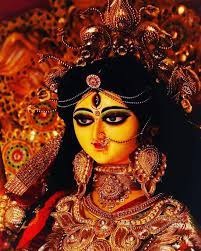The ritual, a significant part of the Maha Ashtami celebrations during the five-day Durga Puja festival, drew hundreds of devotees who gathered to witness this ancient tradition
In a remarkable display of reverence for female divinity, a five-year-old girl was worshiped as the living embodiment of Goddess Durga during the ‘Kumari Puja’ ritual organized by the Shri Shri Bholananda Sevashram in Agartala on Friday.
The ritual, a significant part of the Maha Ashtami celebrations during the five-day Durga Puja festival, drew hundreds of devotees who gathered to witness this ancient tradition.
Kumari Puja, the worship of a young, pre-pubescent Brahmin girl as the manifestation of divine female energy, or Devi, holds special significance in South Asian religious practices.
The term “Kumari” translates to “virgin” in Sanskrit, reflecting the purity and innocence the young girl symbolizes.
This ritual, which dates back to ancient India, was popularized in the modern era by Swami Vivekananda, the founder of the Ramakrishna Math and Ramakrishna Mission (RMRM), who introduced it at the Belur Math in 1901.
The preparation for the ritual began over two months ago, with meticulous attention to tradition.
The young Kumari, who had not yet reached puberty, was selected based on her innocence, purity, and lack of worldly desires.
Early on Maha Ashtami, she was bathed and adorned in a red sari, symbolizing the strength and power of the goddess.
The Kumari was further embellished with flowers, jewelry, and a sindur (vermillion) tilak applied to her forehead, marking her divine status.
The young girl fasted throughout the day, as is customary, and was seated before the idol of Goddess Durga on a specially decorated chair.
Priests chanted hymns while the rhythmic beat of the dhak (traditional drum) created an atmosphere of devotion.
According to religious beliefs, the divinity of the goddess descends into the Kumari during the puja, making her the living embodiment of Durga for the duration of the ritual.
Kumari Puja, although primarily observed in the centers of the Ramakrishna Math, has also been practiced in a few other pandals across India.
It holds a deep symbolic value, underscoring the importance of honoring women, especially young girls, who represent purity and potential.
In a country where female foeticide still remains a challenge in some regions, particularly in northern states, this ancient tradition serves as a reminder of the deep respect and divine status traditionally accorded to women in Indian culture.
It highlights the spiritual significance of womanhood and the importance of nurturing and protecting female life.
The Kumari Puja at Shri Shri Bholananda Sevashram is part of a broader celebration of Durga Puja in Tripura, where the festival holds both religious and cultural significance.
The ritual was a focal point of this year’s Maha Ashtami celebrations, drawing participants from across the region, eager to seek blessings from the living goddess.
As the Durga Puja festivities continue, the Kumari Puja remains a poignant reminder of the sacred role of women in both mythology and society, inspiring reflection on how these traditions can influence contemporary issues surrounding gender and equality in India.




